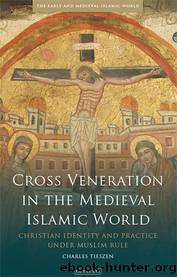Cross Veneration in the Medieval Islamic World by Tieszen Charles;

Author:Tieszen, Charles;
Language: eng
Format: epub
ISBN: 4850456
Publisher: I. B. Tauris & Company, Limited
Conclusion
Arising out of the explanations for cross veneration that are examined in this chapter are some of the most innovative arguments we have encountered in our study. To be true, these authors cover much of the same ground that we have seen in previous chapters, but they also offer rather unique reflections on why the cross is venerated by Christians and how this practice functions in the context of Christian worship and identity.
For Abū Rā'iṭah, honouring the cross meant honouring a wooden cross. His assertion is unlike any of the arguments employed by other others justifying their veneration of the cross. It seems that Abū Rā'iṭah intended his stipulation for wooden crosses to imbue the Christian symbol with special honour so that it could aptly emphasise monotheism in a context of idolatrous accusations. It is not evident how effective Abū Rā'iṭah's argument was, but his other justification for veneration, that the cross of Christ was the Christian qiblah, was powerfully innovative. It allowed Abū Rā'iṭah, and the other authors who picked the argument up, to contextualise the Christian practice of cross veneration for their Islamic contexts. In this way, veneration of the cross could be described in much the same way as Muslim practices such as facing and venerating the Black Stone of the Ka‘bah in Mecca.
This was not Abū Rā'iṭah's only innovative argument arising out of a defence for cross veneration. He also argued that the cross was Christ's sign on earth and preceded his second coming. Other authors, too, made a similar argument. The author of al-Jāmi‘ wujūh al-īmān even asserted that Christ was somehow present in the cross. It was his proxy on earth. As such, it stood in for Christ and was worthy of his people's veneration.
Perhaps most importantly, each of these arguments functioned as means for distinguishing Christian communities from non-Christian ones. In contexts where language and thought-forms, not to mention aspects of doctrine and practice, were quite similar, it was the cross that made Christians unique. In contexts where religious communities faced certain directions and certain objects in worship, Christian communities were distinguished as the ones who faced the cross. Their qiblah was the cross. They were the ones who made the sign of the cross when they prayed. At the return of Christ, it would be the symbol of Christian communities that would signify victory and judgement, not crushing defeat. In short, in multi-religious contexts, venerating the cross was an indispensable act to the Christian life. The cross of Christ made the difference.
Download
This site does not store any files on its server. We only index and link to content provided by other sites. Please contact the content providers to delete copyright contents if any and email us, we'll remove relevant links or contents immediately.
| Africa | Americas |
| Arctic & Antarctica | Asia |
| Australia & Oceania | Europe |
| Middle East | Russia |
| United States | World |
| Ancient Civilizations | Military |
| Historical Study & Educational Resources |
Empire of the Sikhs by Patwant Singh(22174)
The Wind in My Hair by Masih Alinejad(4426)
The Templars by Dan Jones(4191)
Rise and Kill First by Ronen Bergman(4013)
The Rape of Nanking by Iris Chang(3518)
12 Strong by Doug Stanton(3059)
Blood and Sand by Alex Von Tunzelmann(2610)
The History of Jihad: From Muhammad to ISIS by Spencer Robert(2208)
Babylon's Ark by Lawrence Anthony(2072)
No Room for Small Dreams by Shimon Peres(1991)
The Turkish Psychedelic Explosion by Daniel Spicer(1990)
Gideon's Spies: The Secret History of the Mossad by Gordon Thomas(1951)
Inside the Middle East by Avi Melamed(1941)
The First Muslim The Story of Muhammad by Lesley Hazleton(1885)
Arabs by Eugene Rogan(1836)
Bus on Jaffa Road by Mike Kelly(1785)
Come, Tell Me How You Live by Mallowan Agatha Christie(1769)
Kabul 1841-42: Battle Story by Edmund Yorke(1650)
Citizen Strangers by Robinson Shira N.;(1536)
